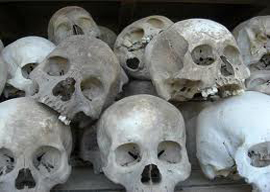
November 06, 2011

“One of the things that amazed me,” says a Vietnam medic in Lt. Col. Grossman’s book, “is how many bullets can be fired during a firefight without anyone getting hurt.”
Killing is rather like fecundating: millions of bullets, only one hit. And like sex for the Victorians, Grossman says it is partly because we repress frank discussion of violence that it has become such a problem. We are never exposed anymore to the slaughtering of a pig or to a grandfather dying in the room upstairs and laid out in the parlor. Actual death is hidden away while visions of virtual death are widespread, which Grossman says is like applying military-conditioning techniques to the youth at large: realistic video games toning the reflexes, blood and gore on the cinema screen associated with the pleasurable responses of candy in the boy’s mouth and his date in the next seat.
In David Grossman’s novel a character called Avram is tortured to within an inch of his life. “It would have been better if they’d gone that extra distance” is all he has to say upon liberation. But there are worse things one can do to a man than to torture and kill him, says Lt. Col. Dave Grossman—for example, making him kill:
In WWI 504,000 men were lost to the fighting effort because of psychiatric collapse and at one point psychiatric casualties were discharged faster than new recruits were being drafted in. In the 1982 incursion onto Lebanon, Israeli psychological casualties were twice as high as the number of dead.
The symptoms of these collapses are not found in civilian populations exposed to the same risks as soldiers. Killing, not fear of being killed, is what murders sanity.
Wolves actually don’t kill each other that much, but men do. Animals are nicer than us, Lt. Col. Grossman seems to say—“Aggression yes. Competitiveness yes. But a very tiny level of actual violence.” To their credit, the ancients were more like animals. As Professor Arthur Nock of Harvard was fond of saying, wars between the Greek city-states were “only slightly more dangerous than American football.” Beasts and Greeks are more peaceful than us.
Though Mexico has only a little over a third the population of the USA, there were nearly as many murders here last year. Here in the capital, men on the subway read El Grafico, whose front page is indeed very graphic and equally divided between Ares and Aphrodite: one half for dead bodies under an overpass, the other for a girl’s naked backside.
Up north, when experts look for causes of violence they drag in lead paint and unwed mothers, overlooking power structures and laws—those made in Congress and the courthouses and those of the market. Down here there is quite clearly a war going on. Shots fired in Juarez, Mexico, have been known to land on the walls of City Hall in El Paso, Texas.
On the Day of the Dead, the price of flowers goes up at the cemetery. I arrived too late to see the families picnicking on the tombs of their loved ones, but I read about it in the paper.
We never learn if Ora’s son dies or not, but in the early morning of August 12th, 2006, novelist David Grossman received the real-life visit from which his fictional character had been fleeing: His son had been killed in Lebanon.
At the end of his book, Grossman—the killologist, not the novelist—brings up the point that if our helicopter Medevacs, 911 operators, paramedics, and trauma centers weren’t so advanced, our murder rate would be much higher—three or four times higher, according to the Harvard and University of Massachusetts study he quotes.
There were 4.8 murders per 100,000 people in the United States last year. Multiplied by four if the attempts had not been foiled by medical technology, that’s 19.2—just above the 18.4 per hundred thousand recorded in Mexico.